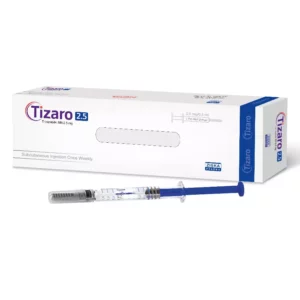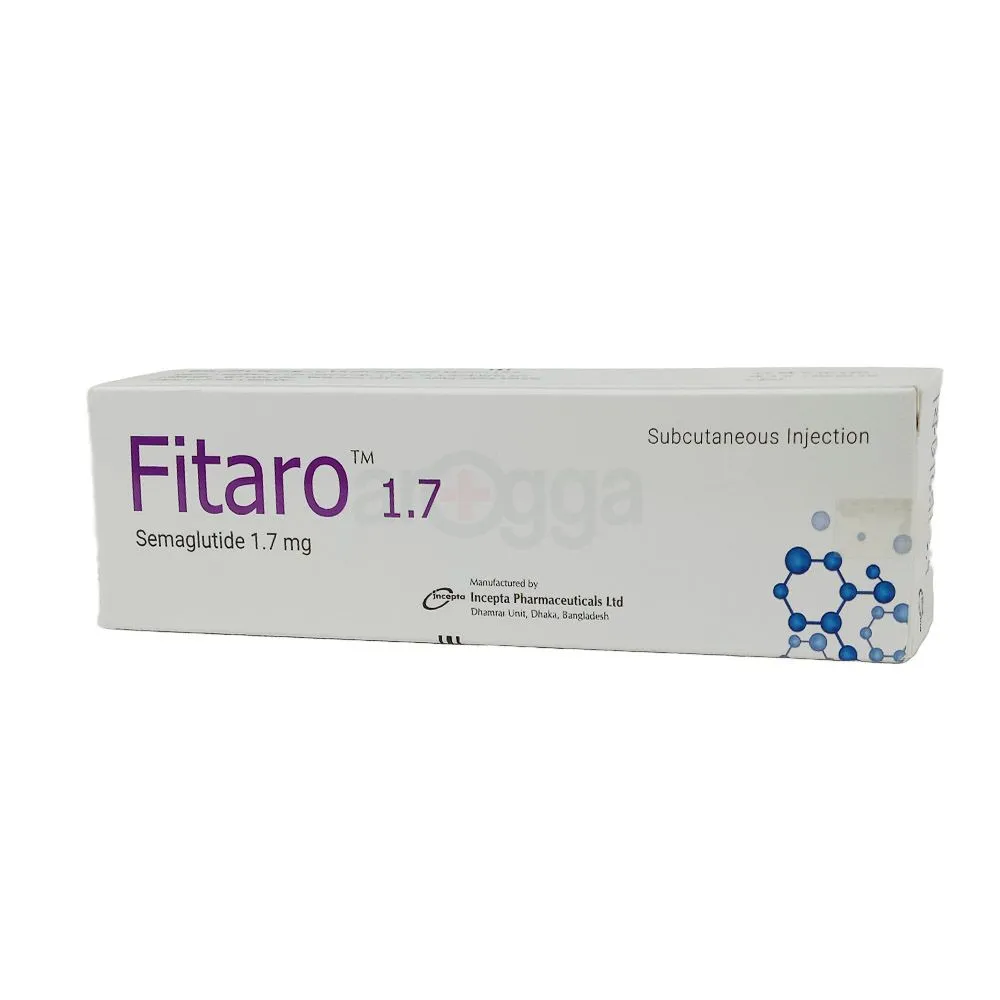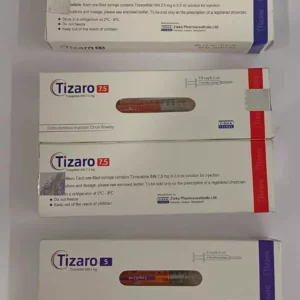Presentation
Fitaro 0.25 mg injection: Each pre-filled syringe contains Semaglutide INN 0.25 mg in 0.5 ml solution for injection.
Fitaro 0.50 mg injection: Each pre-filled syringe contains Semaglutide INN 0.50 mg in 0.5 ml solution for injection.
Fitaro 1 mg injection: Each pre-filled syringe contains Semaglutide INN 1 mg in 0.5 ml solution for injection.
Fitaro 1.7 mg injection: Each pre-filled syringe contains Semaglutide INN 1.7 mg in 0.75 ml solution for injection.
Fitaro 2.4 mg injection: Each pre-filled syringe contains Semaglutide INN 2.4 mg in 0.75 ml solution for injection.
Description
Semaglutide is a GLP-1 analogue with 94% sequence as same as human GLP-1. Semaglutide acts as a GLP-1 receptor agonist that
selectively binds to and activates the GLP- receptor. GLP-1 is a physiological regulator of appetite and caloric intake. It is also present
in several areas of brain that involved in appetite regulation. Semaglutide lowers body weight through decreased calorie intake and by
an overall reduced appetite. It also stimulates insulin secretion and reduces glucagon secretion in a glucose dependent manner.
Indications
An adjunct to a reduced calorie diet and increased physical activity for chronic weight management in adult patients with an initial body
mass index (BMI) of :
• 30 kg/m2 or greater (Obesity) or
• 27 kg/m2 or greater (Overweight) in the presence of at least one weight-related comorbid condition (e.g. hypertension, type 2 diabetes
mellitus or dyslipidemia).
Dosage and Administration
The starting dose is 0.25 mg Semaglutide once weekly for 4 weeks subcutaneously. Then in 4 weeks intervals dose should be
increased until a dose of 2.4 mg is reached. Patient should follow the dose escalation schedule given below.
Dose Escalation Schedule
| Weeks | Weekly Dose | Dose Escalation |
| 1 through 4 | 0.25 mg | |
| 5 through 8 | 0.5 mg | |
| 9 through 12 | 1 mg | |
| 13 through 16 | 1.7 mg | |
| Week 17 and onwards | 2.4 mg | Maintenance dose |
If patients do not tolerate a dose during dose escalation, consider delaying dose escalation for 4 weeks. If patients do not tolerate the
maintenance dose 2.4 mg , the dose can be temporarily decreased to 1.7 mg once weekly for maximum 4 weeks. After 4 weeks
increase the dose to 2.4 mg. Semaglutide is to be administered once weekly at any time of the day with or without meals. Semaglutide
is to be injected subcutaneously in the abdomen, thigh or in upper arm.
Missed dose
If one dose is missed and the next scheduled dose is more than 2 days away (48 hours), administer Semaglutide as soon as possible. If
one dose is missed and the next scheduled dose is less than 2 days away (48 hours), do not administer the dose. Resume dosing on
the regular scheduled day of the week.
Contraindications
Personal or family history of medullary thyroid carcinoma or in patients with Multiple Endocrine Neoplasia Syndrome type 2.
Hypersensitivity to the active substance or to any of the excipients.
Warnings & Precautions
Pancreatitis: Semaglutide should be discontinued promptly if pancreatitis is suspected and it should not be restart if pancreatitis is
confirmed.
Acute Gallbladder Disease: If cholelithiasis is suspected, gallbladder studies and clinical follow-up are indicated.
Hypoglycemia: Concomitant use with an insulin secretagogues or insulin may increase the risk of hypoglycemia. Reducing the dose of
insulin secretagogue or insulin may be necessary.
Diabetic Retinopathy: Patient with diabetic retinopathy should be monitored.
Heart Rate: Heart rate should be monitor at regular intervals.
Suicidal behavior and Ideation: Monitor should be done for depression or suicidal thoughts. If symptoms develop, semaglutide should
be discontinued.
Adverse Reaction
The most common adverse reactions are: nausea, diarrhea, vomiting, constipation, abdominal pain, headache, fatigue, dyspepsia,
dizziness, abdominal distension, eructation, hypoglycemia in patients with type 2 diabetes, flatulence, gastroenteritis, and
gastroesophageal reflux disease.
Drug interaction
Semaglutide lowers blood glucose and can cause hypoglycemia. The risk of hypoglycemia is increased when it is used in combination
with insulin secretagogues (sulfonylureas) or insulin. So when initiating Semaglutide, the dose of concomitantly administered insulin
secretagogue (sulfonylureas) or insulin should be reduce.
Special population
Elderly: No dose adjustment is required based on age.
Renal impairment: No dose adjustment is required for patients with mild moderate or severe renal impairment.
Hepatic impairment: No dose adjustment is required for patients with hepatic impairment.
Pregnancy and Lactation
Semaglutide should not be used during pregnancy. If a patient wishes to become pregnant Semaglutide should be discontinued at least
2 months before a planned pregnancy. As a risk to a breast-fed child cannot be excluded, Semaglutide should not be used during
breast-feeding.
Paediatric population: The safety and efficacy of Semaglutide in children and adolescents below 18 years have not yet been
established. No data are available.
Overdose
The most commonly reported adverse reaction was nausea, vomiting and hypoglycemia. All patients recovered without complications.
In the event of overdose appropriate supportive treatment should be initiated according to the patients clinical sign and symptoms.
Storage
Store at 2 C to 8 C (in a refrigerator). Do not freeze. Keep out of reach of children.
















Reviews
There are no reviews yet.